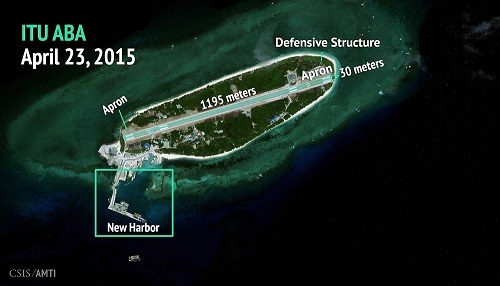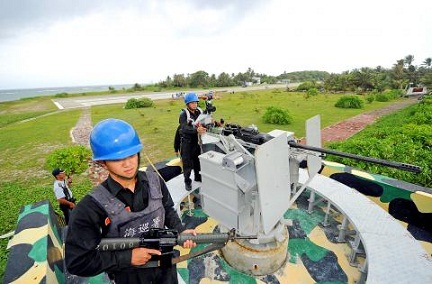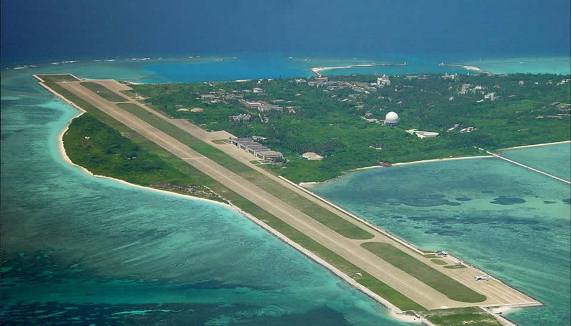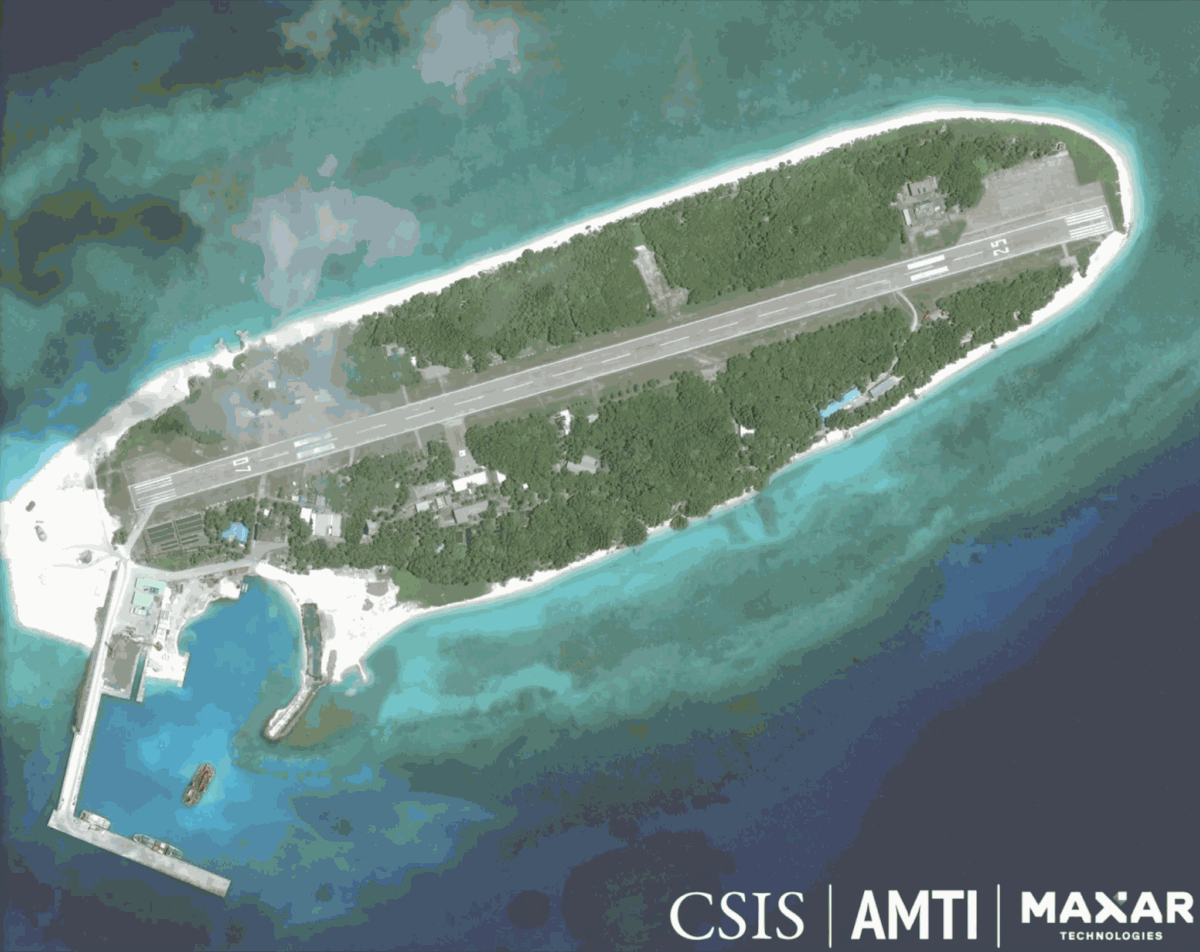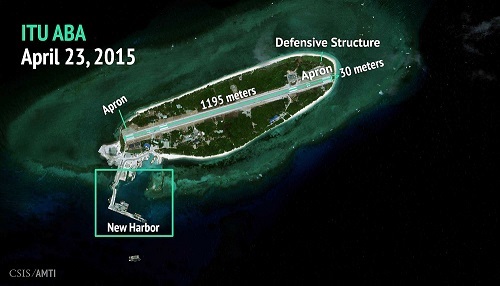
By ELLEN T.TORDESILLAS IS the water coming from the grounds of Itu Aba (Chinese name: Taiping; Philippine name: Ligaw) suitable for drinking?
The answer to this question is crucial in determining whether Itu Aba is an island or a rock.
The determination of Itu Aba’s feature- whether a rock or an island- is important in establishing the extent of the Philippine’s territory and coverage of its sovereignty.
Itu Aba, occupied by Taiwan, is the biggest feature in the Spratlys in South China Sea which is being claimed wholly by China and Taiwan and partly by Philippines, Vietnam, Malaysia and Brunei. The United Nations Convention on the Law of the Sea or UNCLOS defines an island as “a naturally formed area of land, surrounded by water, which is above water at high tide.” An island is entitled to maritime regimes similar to a land territory: territorial sea (12 nautical miles from the baseline), contiguous zone (24 nm), economic exclusive zone (200 nm), continental shelf (200 nm) and extended continental shelf (350nm). On the other hand, “rocks which cannot sustain human habitation or economic life of their own shall have no exclusive economic zone or continental shelf,” according to UNCLOS.
The issue of whether Itu Aba is a rock or an island has again come to the fore with the visit of Taiwan’s outgoing President Ma Ying-jeou there last Jan. 28. In his speech addressing the troops stationed in Itu Aba, Ma voiced his resentment that Taiwan had been ignored in the arbitration case filed by the Philippines against China before the U.N Arbitral Tribunal when Itu Aba was included among the Spratlys features being contested.
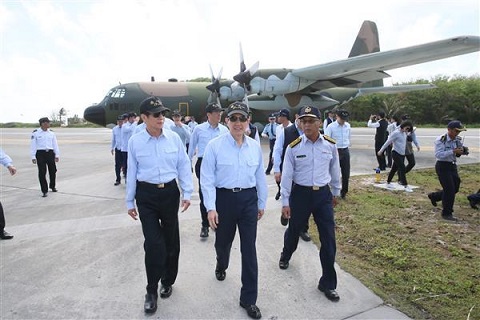
Ma said:“The Philippines sought arbitration with the Permanent Court of Arbitration in 2013 concerning competing claims with mainland China vis-à-vis the South China Sea. This arbitration is of particular importance to our country, yet we have not been invited to participate, nor has our opinion on the matter been sought. “
Foreign Affairs officials explained that the Philippines has no diplomatic relations with Taiwan because it adheres to the One China policy, which recognizes the Beijing government as representative to the Chinese people. The People’s Republic of China considers Taiwan as its province.
The Philippines’ relations with the Republic of China (Taiwan), robust as it is, is limited to “people to people.” Political exchanges with Taiwan are banned under the One- China policy. Moreover, Taiwan is not a member of the United Nations.
In his speech, Ma talked lengthily about Itu Aba or Taiping’s capability to sustain human habitation. He said: “The Philippines holds that Taiping Island has no freshwater, and no arable soil, claiming that food and water must all be imported and human habitation is impossible. This, the Philippines says, means that it is not an island, but a rock, to which no claim can be made on territorial waters beyond 12 nautical miles. However, such statements find no basis in either science or fact; they are totally wrong. The economic, environmental, and cultural realms all provide evidence sufficient to show that the island has—and has had for over 100 years—ample resources to be self-sufficient.
“Geological study of the island shows that Taiping Island was formed perhaps 3 million years ago. Roughly 20,000 years ago, it rose upward to 100 meters above sea level. Perhaps this sheds light on why Taiping Island became the only island in the Nanshas to have its own sources of potable water. “Annual rainfall on Taiping Island is roughly 3,000 mm. Rainwater is either trapped by the soil or seeps down into the coral below. The coral layer further down, having been there for a million years, has been lithified and become impervious to water, meaning that the island has a rich supply of groundwater. Water from the best well, the No. 5 well, has been tested by experts and found to be close to that marketed internationally under the brand name Evian in terms of conductivity and total dissolved solids. It can be drunk directly, and tastes as good as mineral water sold in stores. “Historical documentary evidence attests to the presence of freshwater on the island. The earliest appearance of such documents is in 1879, with the Royal Navy’s The China Sea Directory, in which it attests to the use of Taiping Island by Chinese fishermen and the presence of wells, of which it states, ‘The water found in the well on that island was better than elsewhere.’
“ In 1939, a survey report on Taiping Island by a technician working at Taichu Prefecture (today’s Taichung City, Changhua County, and Nantou County) states that ‘the island has abundant potable water, sufficient for both fishing vessels and for use on the island itself.’ “ In 1946, a report written during a survey of the Nansha Islands by an ROC naval flotilla states that ‘there are several wells on the island, the water drawn from which is excellent.’
“In 1994, the Council of Agriculture, in ‘Nanhai Shengtai Huanjing Diaocha Yanjiu Baogao,’ a report on the ecology of the South China Sea, states that the freshwater at two places on Taiping Island is of better quality than that found in most rivers or lakes. The Coast Guard Administration, meanwhile, last December released ‘Living Conditions on Taiping Island,’ which states that of the four wells on the island, the water of one is used to raise tilapia, while the other three can provide 65 tons of freshwater daily, and that on the average freshwater accounts for 92 percent of water drawn from these wells. Water drawn from Well No. 5, meanwhile, is 99 percent freshwater of good quality. History thus attests to the plenitude and quality of freshwater on Taiping Island, sufficient to support human life.”
In the hearing of Arbitral Tribunal on the Philippine suit against China in The Hague November last year, the Philippine panel presented an expert who testified that there is no freshwater in Itu Aba and cannot sustain human habitation. Therefore, it is a rock. We will discuss this in the next column.
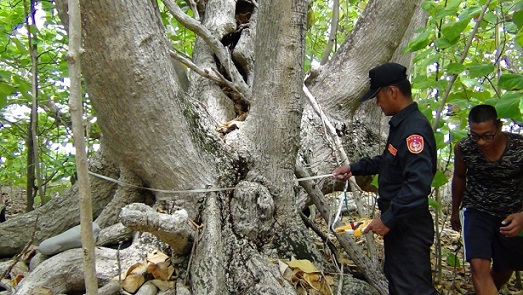
PART II (Conclusion)
THE issue of whether Itu Aba (also known by its Chinese name “Taiping” and Philippine name “Ligaw”) is an island or a rock has become a battle of experts.
In the hearing at The Hague last Nov 30 on the Philippine suit against China’s nine-dash-line and constructions in submerged maritime features in the Spratlys, the American lawyer of the Philippines, Paul Reichler, presented a 1994 study which was the result of a botanical expedition funded by the Republic of China (Taiwan)’s Council of Agriculture, Executive Yuan. Reichler quoted from the study which stated: “The underground water is salty and unusable for drinking.”
Reichler said “There is no potable water. Drinkable water by itself may not be a sufficient condition to sustain human habitation, but it is certainly a necessary one. Itu Aba does not satisfy it.” The American lawyer also said “The island is an atoll consisting of a tropical 10 reef covered with sandy coral and shell.” That is: no topsoil. … Without tillable soil, there is no agricultural production sufficient to sustain human habitation.”
Reichler concluded: “This (Itu Aba) is a rock.”
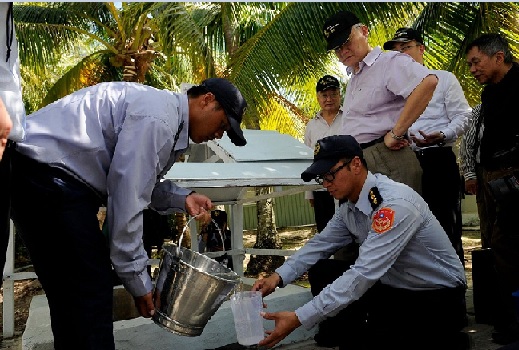
Rocks, according to the United Nations Convention on the Law of the Sea or UNCLOS, “which cannot sustain human habitation or economic life of their own shall have no exclusive economic zone or continental shelf.”
In a lecture on the South China Sea at Ateneo de Manila last year, Senior Associate Justice Antonio T. Carpio said if the U.N. Tribunal favors the Philippine government’s assertion that Itu Aba is not capable of human habitation or economic life of its own, “the tribunal will then declare that Palawan has a full 200 nautical mile Economic Exclusive Zone facing the West Philippine Sea.” The implication of this is astounding.
“This means,” Carpio added, “that all submerged features within this EEZ, like the Reed Bank and Malampaya, are subject to exclusive economic exploitation by the Philippines in terms of fisheries, oil and gas, and mineral resources.”
Furthermore, Carpio said, “If the Philippines has a full 200 NM EEZ in Palawan facing the West Philippine Sea, only the Philippines can create artificial islands on submerged areas or erect structures on LTEs (Low Tide Elevation) within its 200 NM EEZ. Artificial structures or reclamations made by other countries, namely by China and Vietnam, are illegal.”
What about if the U.N. Tribunal ruled Itu Aba is an island, capable of human habitation or economic life of its own?
Carpio said, then the case as far as Itu Aba and Palawan are concerned becomes an issue of overlapping EEZs (The distance between Palawan and Itu Aba is 225 NM), outside of the tribunal’s jurisdiction in view of China’s reservation excluding boundary delimitation issues from compulsory arbitration.
The Philippine legal panel presented in the The Hague hearing Australian Professor Clive Schofield, an expert in maritime boundary delimitation and marine jurisdictional issues and has written a number of articles on Itu Aba.
Schofield told the tribunal: “At first glance, Itu Aba and one or two of the other partially vegetated and occupied features may appear as though they might be able to escape the net of Article 121(3). However, on closer examination, they cannot, because they lack the key requirement for full island status, namely the presence of civilian populations, the availability of potable water, and the existence of agricultural or economic activity. Not coincidentally, they are also rather small. “
Article 121 (3) is UNCLOS definition of rocks. Schofield further said, “That is why we reached the conclusion, from a scientific and geographic perspective, and having regard for the conditions set out in Article 121(3), that Itu Aba is most appropriately treated as an Article 121(3) “rock”.
Taiwan, which occupies Itu Aba, and like China also claims almost the whole of the South China Sea (some of the features in the area are also being claimed by the Philippines, Vietnam, Malaysia and Brunei) insists Itu Aba is an island. Taiwan is not a participant in the The Hague hearing but recently, Yann-huei Song, a research fellow in the Institute of European and American Studies, Academia Sinica in Taipei, wrote in Asia Maritime Transparency Initiative online site attesting that water in Itu Aba is potable.
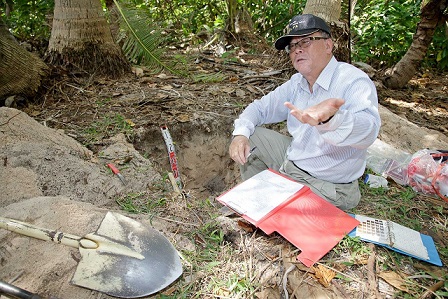
He said he has been to Itu Aba four times. He belittled the testimony of Schofield, who, he said, has never been to Itu Aba. Yan-Huei said “But I suspect he (Schofield) would change his opinion if he were invited to visit the island and, like me, had the chance to drink fresh water from the skimming well and eat a lunch of cooked vegetables and fruits picked from the island’s garden.”
The Philippine legal team latched on to the term “skimming well.”
Reichler said according to the United States Department of Agriculture, the skimming well is a technique employed with an intention to extract relatively freshwater from the upper zone of the fresh-saline aquifer. “
Reichler further said: “Certainly the Taiwanese troops on Itu Aba could not survive from whatever it is that this facility produces. That is why Taiwan built two modern desalination facilities in 1993. And that constitutes further proof that there is no naturally occurring water on the feature that is suitable for drinking, much less sustaining human habitation.”
Yan-Huei’s article said:”During my four visits to Itu Aba, I have seen indigenous plants that are more than 32 feet (10 meters) tall. There is a nearly 4,000-foot (1,200-meter) runway, two piers, a guest-house building, a postal office, a small hospital, a big agricultural garden, livestock, and a temple. In addition to drinkable water that is available at the four skimming wells, indigenous soil on the island has also long been used for growing fruits, including banana, coconut, and papaya, and vegetables such as wild bitter squash, loofah, and cabbage. It should also be noted that internet and cell phone access are available on Itu Aba, along with solar power for electricity.”
All those amenities, of course, do not answer the basic question: Is Itu Aba an island or a rock? We await the U.N. Arbitral Tribunal’s word on that.
